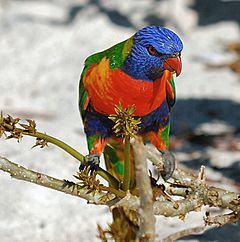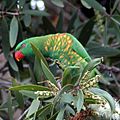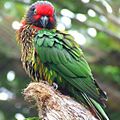Lories and lorikeets facts for kids
Quick facts for kids Lories and lorikeets |
|
|---|---|
 |
|
| Rainbow lorikeet | |
| Scientific classification | |
| Kingdom: | |
| Class: | |
| Order: | |
| Superfamily: | |
| Family: |
Psittaculidae
|
| Subfamily: |
Loriinae
|
| Tribe: |
Loriini
|
Lories and lorikeets are amazing, colorful parrots. They are small to medium-sized birds. These birds live in trees. They have special brush-tipped tongues. This helps them eat nectar from flowers. They also enjoy soft fruits like berries.
Lories and lorikeets are a special group of parrots. They are part of the larger parrot family. Scientists have studied them closely. These studies show they are related to other parrots. This includes the popular budgerigar and fig parrots.
You can find these birds in many places. They live across the Australasian region. This includes Australia, Papua New Guinea, and parts of south-eastern Asia. Most lories and lorikeets have very bright feathers.
Contents
What Lories and Lorikeets Look Like
Lories and lorikeets have unique tongues. Their tongues are like brushes. This helps them collect nectar and soft fruits. They can feed from thousands of different flowers. The tip of their tongue has tiny hairs. These hairs are called papillae. They help gather nectar and pollen.
The rainbow lorikeet is a very famous parrot. It was shown in early bird books. People have always thought lories and lorikeets are beautiful. They are known for their many bright colors.
What Lories and Lorikeets Eat
In the wild, rainbow lorikeets eat mostly pollen and nectar. Their special tongues help them with this diet. Sometimes, they visit fruit orchards. They can eat a lot of fresh fruit in groups. This makes some fruit farmers unhappy.
These birds also visit bird feeders. People put out special treats for them. These treats include nectar mixes and sunflower seeds. Lories and lorikeets also enjoy fruits. They like apples, grapes, and pears. Sometimes, they have even been seen eating meat.
Protecting Lories and Lorikeets

Some lory and lorikeet species are in danger. The ultramarine lorikeet is very rare. It is one of the rarest birds in the world. The blue lorikeet is also vulnerable.
One big problem is European rats. These rats were brought to the islands where the birds live. The rats eat the birds' eggs and young. This causes the bird populations to shrink. People are working to help these birds. They move some birds to safer places. These new places do not have rats. They also have healthy habitats.
Lories in Stories
A "Lory" character appears in a famous book. It is in Lewis Carroll's Alice's Adventures in Wonderland. Alice has a funny argument with the Lory. They argue about how old the Lory is.
Images for kids
-
Green-naped lorikeet (subspecies of rainbow lorikeet)
-
Australian rainbow lorikeet (subspecies of rainbow lorikeet)
-
Black-capped lory at the Cincinnati Zoo
-
Chattering lory at Jurong Bird Park
See also
 In Spanish: Loriini para niños
In Spanish: Loriini para niños
















